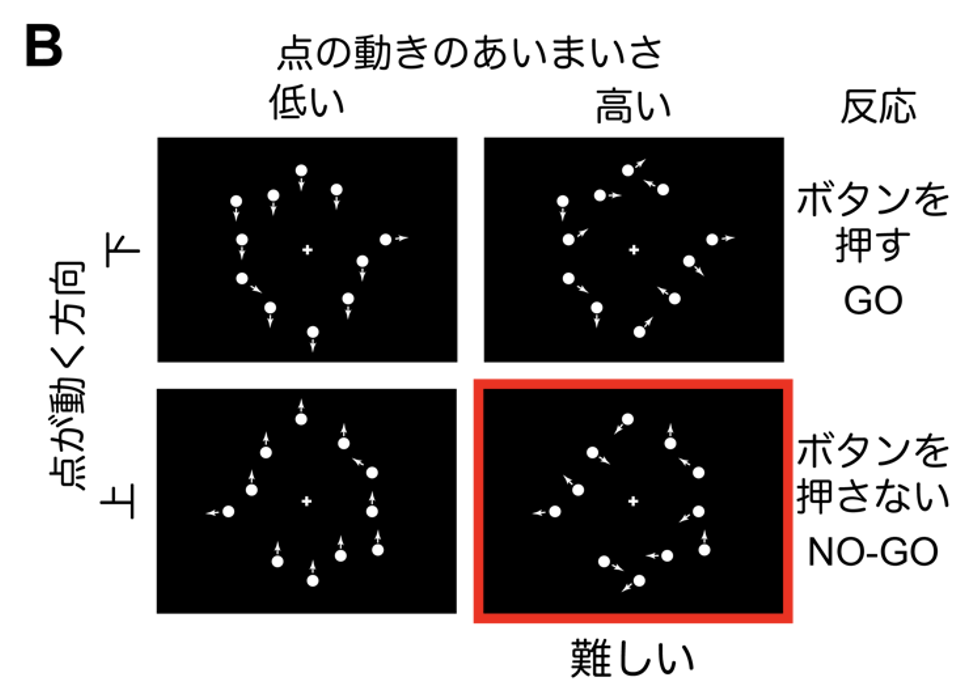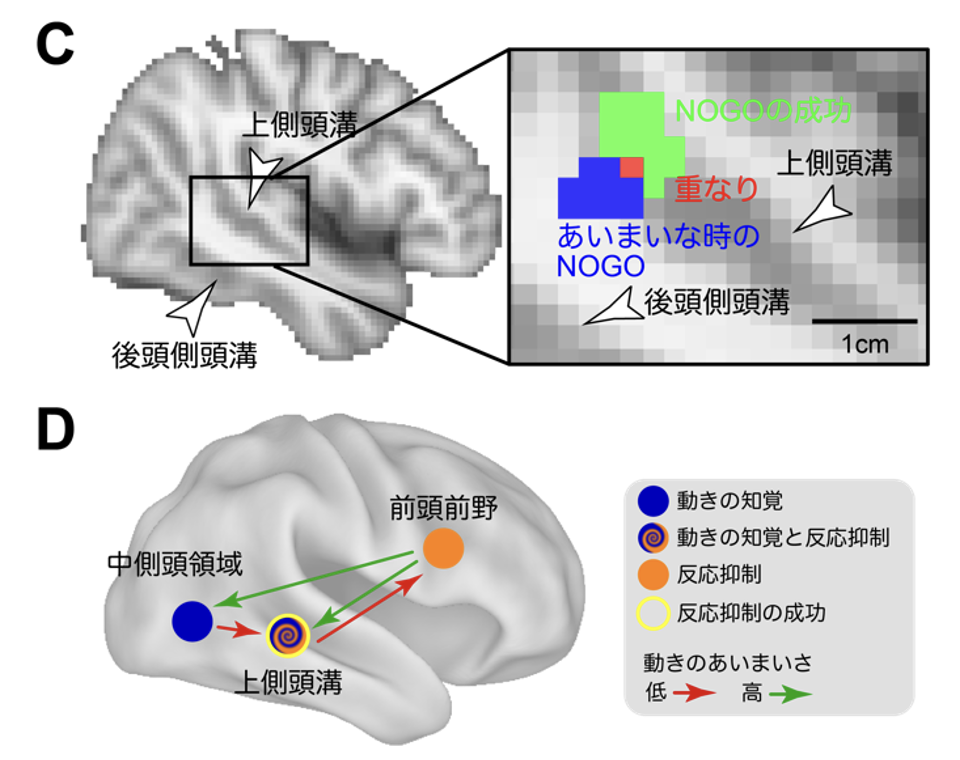研究成果発表:わかりにくい状況で不適切な反応を抑制する脳機構を解明 認知の制御と知覚のトリロジー
【概要】
慶應義塾大学大学院理工学研究科修士課程の津村夏帆と新滝玲子(研究当時、それぞれ2019年、2022年に修了)、同理工学部生命情報学科の地村弘二准教授は、高知工科大学の中原潔教授、竹田真己特任教授、株式会社アラヤの近添淳一チームリーダーらとの共同研究で、外界の情報に不確かさがある状況で不適切な行動を抑制するとき、ヒト脳の上側頭溝を経由する前頭前野と後頭側頭皮質の信号伝達が逆転することを発見しました。今回の結果は、外界の知覚に依存している反応抑制が、上側頭溝を中心とした前頭前野-側頭葉の回路によって実現されていることを示しています。そして、ヒトに特有な高度な認知の機能が、大規模で精緻な神経回路により実現されていることを例示しています。この研究は米国神経科学学会(Society for Neuroscience)が発行するThe Journal of Neuroscienceの速報版で5月2日発表されました。
【1.本研究のポイント】
・適切な行動が不確かな状況で、ヒトが不適切な反応を抑制するときの脳の活動を測定した。
・知覚が不確かな状況では、適切な反応をするよりも、不適切な反応を抑制する方が難しかった。
・不適切な反応を抑制するとき、不確かさに応じて前頭前野と後頭側頭皮質の信号伝達が逆転した。
【2.研究背景】
不適切な反応を抑えることは、変化する環境に適応するための認知の制御機能です。たとえば、交差点の信号が緑なら進み、赤で止まることにより、身の安全が確保されます(図A)。この不適切な反応を抑える「反応抑制」は、ヒトでは右大脳半球の前頭前野が関わる重要な制御機能として知られています。
しかし、私たちの日常生活では、身の回りの重要な情報が常に適切に判別できるわけではありません。信号の例ですと、色が判別しにくいことがあります。たとえば、もし信号が緑と赤が混ざったような色をしていたら、進むのか、止まるのか、判断が難しいという問題が生じます(図A)。実際には信号が赤と緑の混ざったような光を出すことはないとしても、日差しの加減で色が判別しにくくなることはよくあります。ところが、これまでの反応抑制の研究では、行動する状況が明確に判別できることが前提になっていました。
一方で、知覚される情報のあいまいさを操作し、判別がどのように変化するかを調べる「知覚的意思決定」の研究では、後頭側頭皮質が視覚情報の様式(たとえば、動き)に依存して判別を導くことが知られています。そこで本研究グループは「知覚的なあいまいさがある状況で、反応抑制は脳の前頭前野と後頭側頭皮質のどのような仕組みにより達成されるのか」という問いを立てました。

【3.研究内容・成果】
本研究グループはまず、動きのあいまいさを操作する視覚刺激を作成しました。この刺激では、小さい点がいくつか提示され、それぞれの点は、上、下、またはランダムに動きます(図B)。この動きのランダムさにより、知覚されるあいまいさが操作されました。
ヒト被験者は、この刺激が提示されたとき、点全体の動きの方向によって、ボタンを押すか、ボタンを押さない(つまり反応の抑制)かを判断することが要求されました。これらをそれぞれ、GO試行、NO-GO試行と呼びます(図B右)。そしてGO試行とNO-GO試行のヒト脳の活動を機能的MRIで測定しました。
点の動きのあいまいさが高くなると、動きの知覚は難しくなるので、間違いが増えます。ここで重要なのは、間違いの増え方が、GO試行よりもN0-GO試行で大きかったことです(図B右下; 統計学的には交互作用といいます)。このことは、知覚のあいまいさが高くなることにより、反応抑制自体が困難になることを示しています。

この「知覚のあいまいさに伴う反応抑制の難しさの上昇」(統計的交互作用)に関連した脳領域を探索したところ、上側頭溝が同定されました(図C青の領域)。この領域の活動は、知覚が容易なNO-GO試行でより大きくなっていました。さらにこの領域は、NO-GO試行が成功した時にも大きくなっていました(図C緑の領域)。
また、NO-GO試行では右の前頭前野の活動が大きくなり、点の知覚のあいまいさが低いときには、上側頭溝の後部にある後頭側頭皮質の中側頭領域の活動が大きくなりました(図D)。これら2領域と上側頭溝の信号伝達の様式を調べたところ、知覚のあいまいさが低いときには、中側頭領域から上側頭溝を経由して前頭前野に反応抑制の信号が伝達される「ボトムアップ信号」が生じることがわかりました(図D赤矢印)。そして、あいまいさが高くなると、この信号の伝達方式が逆転し、前頭前野から上側頭溝と中側頭領域への「トップダウン信号」となることがわかりました(図D緑矢印)。

以上の結果は、反応抑制が、外界から重要な情報を抽出する知覚的意思決定に依存していることを示しています。そして、上側頭溝が、反応抑制に関わる右前頭前野と、知覚的意思決定に関わる後頭側頭皮質の中継領域となり、視覚情報から認知の制御情報への変換において重要な役割を果たしていることを示唆しています。
本研究グループは2021年と2022年に、知覚的意思決定が関わる「行動の柔軟性」において前頭前野と後頭側頭領域の機構を解明しました(参考文献[1、2])。「行動の柔軟性」と本研究が調べた「反応抑制」は主要な認知の制御機能として知られています。本研究グループのこの「トリロジー」(三部作)は、脳活動を計測してヒトの知覚的意思決定と認知の制御の関係を調べる枠組みが科学として成立することを示し、一つの道標としました。
【4.今後の展開】
この三部作を通じて、認知の実行制御と知覚的意思決定の根底にある脳の仕組みについて一貫性のある説明ができたことで、科学的に一つの区切りがついたと感じています。まずはこの三部作の再現性と信頼性の検証をしていきたいと思います。そして関連する分野の研究者が一連の結果を追試し、この分野が発展することを期待しています。
一方で、一連の結果をつぶさに眺めてみると、新たに疑問が生じ、解くべき重要な問題が多くあることに気づきます。今後はこれらの問題を地道に解決し、結果を積み上げながら「自分は何か」という人類にとって究極の問題の解に現代科学の方法で近づきたいと思っています。
【原論文情報】
Tsumura K, Shintaki R, Takeda M, Chikazoe J, Nakahara K, Jimura K (2022) Perceptual uncertainty alternates top-down and bottom-up fronto-temporal network signaling during response inhibition. J Neurosci, doi: 10.1523/JNEUROSCI.2537-21.2022.
【参考文献】
[1] Tsumura K, Aoki R, Takeda M, Nakahara K, Jimura K (2021) Cross-hemispheric complementary prefrontal mechanisms during task switching under perceptual uncertainty. J Neurosci 41, 2197-2213.
慶應義塾大学によるプレスリリース (2021年1月26日):「不確かな環境での行動の切り替え-認知の制御と知覚の補完的な脳機構-」
[2] Tsumura K, Kosugi K, Hattori Y, Aoki R, Takeda M, Chikazoe J, Nakahara K, Jimura K (2022) Reversible fronto-occipitotemporal signaling complements task encoding and switching under ambiguous cues. Cereb Cortex 32,1911-1931.
慶應義塾大学によるプレスリリース (2021年9月16日):「とるべき行動がはっきりしない状況での認知の柔軟性を解明」
【お問合せ先】
株式会社アラヤ
お問い合わせフォーム:https://www.araya.org/contact/

 受託開発・お問い合わせ
受託開発・お問い合わせ